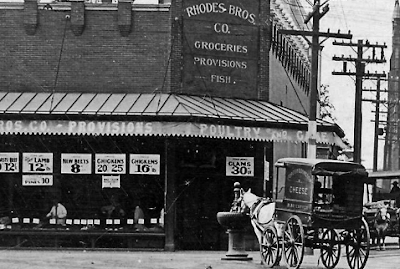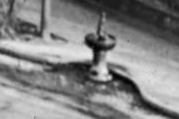Few will think of a place like Brookline.
| Beacon Street, looking east from Englewood Avenue, 1887. This picture was taken not long before the widening of Beacon Street. (Public Library of Brookline via Digital Commonwealth) |
There were plank sidewalks (as they were called) at one time on major thoroughfares like Beacon, Washington, and Harvard Streets and Brookline Avenue, though those soon gave way to more durable materials.
(NOTE: Click on the links in all of the photo captions on this page for larger and/or zoomable views of the photos. You can see additional photos with wooden sidewalks on the Brookline Historical Society website.)
| Beacon Street looking west from Carlton Street, 1887. Public Library of Brookline via Digital Commonwealth |
| Beacon Street looking east from the corner of Washington Street, 1887. Remains of an old tannery are on the right. (Public Library of Brookline via Digital Commonwealth) |
Plank Sidewalks on Residential Streets
Even with the coming of newer materials plank sidewalks continued to be laid on some residential streets in Brookline as late as the 1920s and to be maintained for years after. The last one, in fact, was not removed until 1955!
 |
| Plank sidewalk in front of 54 Gardner Road, 1888 (Brookline Historical Society) |
 |
| Wooden sidewalk on Rawson Road, 1915 (National Park Service. Frederick Law Olmsted National Historic Site) |
 |
| Wooden sidewalk on Bowker Street, date unknown. (Brookline Historical Society) |
 |
| Plank sidewalk in front of the Widow Harris House on Newton Street, date unknown (Brookline Historical Society) |
 |
| Wooden sidewalk, in foreground, on Winthrop Road, looking down on Washington Square, c1900. University Road is in the middle, and Corey Hill is across Beacon Street. (Iowa State University Library Special Collections) |
 |
| This table from the 1907 Brookline Town Report shows where new plank walks were added and old ones replaced in town that year. |
Why did Brookline have wooden sidewalks and why did they last so long?
In 1854, a committee was appointed to look into a proposal from David Sears and others to install a gravel sidewalk and plant shade trees on a part of Beacon Street starting where it met the Mill Dam coming across the Back Bay from Boston. (Beacon Street, then a narrow country lane, had been laid out across Brookline in 1850-51.) The committee, in 1854, deemed that proposal premature in light of uncertainty about further plans for Beacon Street.
Also in 1854, Town Meeting voted to allocate $200 "to make and furnish a suitable gravel sidewalk" in front of the property of "any of the abutters upon any of the highways" of the town if the property owners would supply "edgestones of hammered granite of uniform size, not less than five inches thick" to be placed between the road and their property.
In 1858, Town Meeting took up the question of sidewalks on Beacon Street again, this time voting
That the Selectmen be and are hereby authorized to lay a plank sidewalk across the marsh on Beacon Street, provided the expense does not exceed six hundred dollars and the abutters on said street will make a continuous line of sidewalk up to Kent street.
For the next 11 years, the Town would spend as much as $800 a year on sidewalks in different parts of town. But by 1869, a more concerted effort was called for. A committee appointed in July delivered a report in August that said, among other things, that
The condition of the sidewalks of the town being so bad, your committee would urge that there be no further delay than is absolutely necessary, and recommend the immediate appropriation of eight thousand dollars, to be expended by the Selectmen in laying such walks as they shall deem best suited to the different streets, always remembering that a good sidewalk should protect from mud at all seasons of the year.
The committee further recommended that
Attention should be given first to the main thoroughfares leading to the centre of the village and the railroad stations, laying it on one side of the street only, and, wherever it is practicable, on the south side of the street, that it may the better be kept free from snow and ice. A walk from Walnut street through Cypress and School streets, and Aspinwall avenue to the Episcopal Church, would render all the churches of the town accessible to the majority of the inhabitants.
The eight thousand dollars was approved by Town Meeting. The committee's report, prepared after correspondence with the mayors of New York and other cities and visits to Cambridge and Lawrence and to Concord, New Hampshire, looked at several different materials for sidewalks. These included flagstone, brick, and two types of concrete. Wood was not mentioned, but it continued to be used extensively. (Well into the 1880s, more money was spent on plank sidewalks in some years than on any other kind.)
 |
| This 1888 photo shows Aspinwall Avenue at St. Paul Street with St. Paul's Church in the background. The plank sidewalk can be seen on the lower right and in close-up below. (Brookline Public Library via Digital Commonwealth) |
A 1906 report from Michael Driscoll, Superintendent of Streets and Sewers, noted some of the pluses and minuses of plank sidewalks:
There is no doubt as to the comfort and convenience of plank walks, especially in the winter season, but their maintenance is very costly, and in view of the rapid and continued increase in the price of lumber there is some question as to the advisability of continuing their use.
Expenditures on new plank sidewalks dropped after that, though costly repairs continued to be done. By 1923, Driscoll was recommending against laying any new plank sidewalks at all.
The cost of repairs and renewals of the plank walks is larger than ever before, and in my opinion, the time has come when the policy of laying these walks wherever petitioned for should be discarded.
By 1931, Driscoll's successor, Daniel Lacey, was calling for a halt to even repairs of plank walks and for their replacement whenever they wore out.
Owing to the fact that the cost of maintaining plank walks has increased tremendously during the course of the past few years which necessitated a definite program for the removal of them, it is with a keen feeling of satisfaction that we report the elimination of 8,000 feet of old plank. In a few years, when the full utility has been derived from the existing plank walks, this type of sidewalk will be a matter of history.
But it would be another 24 years before the last of Brookline's wooden sidewalks was gone.
A National Curiosity
As years went by, Brookline’s remaining wooden walkways even drew national attention. In 1942, there were articles in two trade magazines: "City Clings to Wooden Walks" in The American City in May; and "70 Years of Wooden Sidewalks" in Roads and Streets in October.
 |
| Town officials Daniel Lacey, left (mislabeled as "Lace") and Henry Smith, as shown in Roads and Streets. |
The continued presence of the plank sidewalks, according to the article in The American City, was due to "such a clamor from residents who wanted to retain the rustic beauty of their old walks" as well as to the use of new pressure-treated lumber that extended the life of the wood and cut maintenance costs by 54%.
The attention brought by the articles in the two trade publications led to newswire items that were widely distributed and appeared in newspapers around the country.
The policy of eliminating, as rapidly as possible, the dangerous and high maintenance-cost plank and gravel walks throughout the town, will be continued until all have been removed.
In November 1955 the Boston Globe ran a one-paragraph wire service item about the removal of the last wooden sidewalk in the old lumber town of Muskegon, Michigan. Ironically, they seemed unaware that nearby Brookline had only recently removed the last of its own plank sidewalks.
Where was the last wooden sidewalk in Brookline? We may never know. The Town Reports from 1950 to 1954 lists the streets from which they were removed. These included sections of: Warren Street, Cottage Street, and Heath Street (1950); Warren Street, Heath Street, Dudley Way, and Reservoir Road (1951); Heath Street, Colbourne Path, and Gardner Path (1952); Warren Street, Woodland Road, and Addington Path (1953); and Cottage Street and Hayden Road (1954).
But the 1955 report simply says:
The work of removing plank sidewalks in the Town was completed this past year.
 | ||
| Wooden sidewalk on the left at the intersection of Blake Road and Tappan Street, 1915 (National Park Service. Frederick Law Olmsted National Historic Site) |
 | ||||
| Wooden sidewalk in front of the Putterham School at its original location on Newton Street, c1900. (Brookline Historical Society) |
 |
| Close-up views of some of the old plank sidewalks of Brookline |














